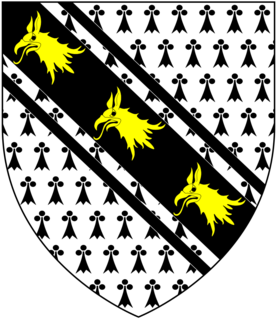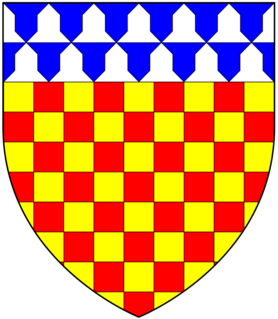
Baron Kilmaine is a title that has been created twice, both times in the Peerage of Ireland. The first creation came in 1722 in favour of the soldier the Hon. James O'Hara. Two years later he succeeded his father as Baron Tyrawley. However, both titles became extinct on the second Baron Tyrawley's death in 1773 without legitimate sons.

Sir Walter Yonge, 2nd Baronet of Great House, Colyton, and of Mohuns Ottery, both in Devon, was a Member of Parliament for Honiton (1659), for Lyme Regis (1660) and for Dartmouth (1667–70).

There have been four baronetcies created for members of the Acland family, which originated in the 12th century at the estate of Acland in the parish of Landkey, North Devon, two in the Baronetage of England and two in the Baronetage of the United Kingdom.
The Fletcher, later Aubrey-Fletcher Baronetcy, of Clea Hall in the County of Cumberland, is a title in the Baronetage of Great Britain. It was created on 20 May 1782 for Henry Fletcher, a Director of the Honourable East India Company and Member of Parliament. He was a descendant of Philip Fletcher, whose brother Sir Richard Fletcher was the father of Sir Henry Fletcher, 1st Baronet, of Hutton in le Forest. Fletcher was succeeded by his son, Henry, the second Baronet. He was High Sheriff of Cumberland from 1810 to 1811. His grandson, the fourth Baronet, was a prominent Conservative politician. In 1903 he assumed by Royal licence the additional surname of Aubrey on inheriting the Aubrey estates on the death of Charles Aubrey. Aubrey-Fletcher died childless and was succeeded by his younger brother, Lancelot, the fifth Baronet. He assumed by Royal licence the additional surname of Aubrey on succeeding to the title in 1910. His eldest surviving son, Henry, the sixth Baronet, was Lord-Lieutenant of Buckinghamshire from 1954 to 1961. He was succeeded by his son, John, the seventh Baronet. He was High Sheriff of Buckinghamshire in 1961. As of 2008 the title is held by his son, Henry, the eighth Baronet, who succeeded in 1992. He is Lord-Lieutenant of Buckinghamshire since 2006.

There have been three baronetcies created for persons with the surname Burdett, two in the Baronetage of England and one in the Baronetage of Ireland. As of 2008 two of the creations are extant while one is dormant.
There have been three baronetcies created for members of the Shelley family, one in the Baronetage of England and two in the Baronetage of the United Kingdom. The three recipients of the titles represented two different branches of the family with a common ancestor in John Shelley of Michelgrove. The most famous member of the family is the poet Percy Bysshe Shelley, although he never held any title. The holders of the third and last creation were later elevated to the peerage as Baron De L'Isle and Dudley and Viscount De L'Isle.
Sir Charles Daniel Cave, 1st Baronet, was a British baronet and banker.
There have been two baronetcies created for persons with the surname Bates, both in the Baronetage of the United Kingdom. As of 2014 both creations are extant.
There have been three baronetcies created for persons with the surname Bellingham, one in the Baronetage of England, one in the Baronetage of Ireland and one in the Baronetage of Great Britain. As of 2014 one creation is extant.
There have been six baronetcies created for persons with the surname Brooke, one in the Baronetage of England, one in the Baronetage of Ireland and four in the Baronetage of the United Kingdom. As of 2015 four of the creations are extant, though one has been subsumed into a peerage.
The Cave, later Cave-Browne, later Cave-Browne-Cave Baronetcy, of Stanford in the County of Northampton, is a title in the Baronetage of England.

There have been three baronetcies created for members of the Blakiston family of Blakiston, County Durham, two in the Baronetage of England and one in the Baronetage of Great Britain. One creation is extant as of 2008.

Sir Jonathan Trelawny, 2nd Baronet, of Trelawny in the parish of Pelynt in Cornwall, England, was a Member of Parliament.

There have been three baronetcies created for persons with the surname Chichester, one in the Baronetage of England and two in the Baronetage of the United Kingdom. Only the 1641 creation is extant.

The Wrey Baronetcy, of Trebitch in the County of Cornwall, is a title in the Baronetage of England. It was created on 30 June 1628 for William Wrey (d.1636), 2nd son of John Wrey of Trebeigh, St Ive, Cornwall, a member of an ancient Devon family. The third Baronet was a supporter of the Royalist cause and sat as Member of Parliament for Lostwithiel after the Restoration. He married Lady Anne, third daughter and co-heir of Edward Bourchier, 4th Earl of Bath, and a co-heir to the barony of Fitzwarine. The fourth Baronet represented Liskeard and Devon in the House of Commons. The fifth Baronet was Member of Parliament for Camelford while the sixth Baronet represented Barnstaple.
The Brooksbank Baronetcy, of Healaugh Manor, in the parish of Healaugh, in the West Riding of the County of York, is a title in the Baronetage of the United Kingdom. It was created on 15 September 1919 for Edward Brooksbank. He was a Justice of the Peace and a Deputy Lieutenant for the West Riding of Yorkshire. He was succeeded by his grandson, the second Baronet. He was a Colonel in the Yorkshire Yeomanry and also served as a justice of the peace and as a Deputy Lieutenant of the East Riding of Yorkshire. Currently, the title is held by his son, the third Baronet, who succeeded in 1983.
There have been three baronetcies created for persons with the surname Pole, one in the Baronetage of England, one in the Baronetage of Great Britain and one in the Baronetage of the United Kingdom. Two of the creations are extant as of 2008.

There have been three Baronetcies created for persons with the surname Seymour, two in the Baronetage of England and one in the Baronetage of the United Kingdom. One creation is extant as of 2008.

Sir Charles Warwick Bampfylde, 5th Baronet of Poltimore in Devon, was a British politician who served twice as Member of Parliament for Exeter, in 1774–1790 and 1796–1812.

Sir Chichester Wrey, 3rd Baronet (1628–1668) of Trebeigh in the parish of St Ive, Cornwall and of North Russell in the parish of Sourton, Devon, was an active Royalist during the Civil War and was Colonel of the Duke of York's Regiment and served as Governor of Sheerness.










